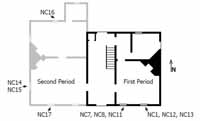Cross-Section Microscopy Analysis of Exterior Paints, Ludwell-Paradise House (Block 18, Building 7)
Colonial Williamsburg Foundation Library
Research Report Series - 1739
Colonial Williamsburg Foundation
Library
Williamsburg, Virginia
2012
Cross-Section Microscopy Analysis of Exterior Paints
Robert Nicolson House
(Block 7, Building 12)
Williamsburg, Virginia
May 2007
Table of Contents
| Purpose | 1 |
| Sampling Procedures | 1 |
| Results of Cross-Section Analysis | 3 |
| Windows | 3 |
| Cornice | 10 |
| Doors | 11 |
| Results of Binding Media Analysis with Fluorochrome Stains | 15 |
| Results of Pigment Identification | 18 |
| Results of Color Measurement | 19 |
| Conclusion | 20 |
| Appendix | |
| Sampling Memorandum | 21 |
| Cross-Section Preparation Procedures | 24 |
| Binding Media Analysis Procedures | 24 |
| Pigment Identification Procedures | 24 |
| Color Measurement Procedures | 25 |
| Contact Sheets of Cross-Section Photomicrographs | 26 |
Cross-Section Microscopy Analysis of Exterior Paints
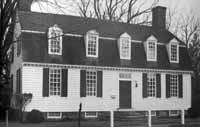 Whiffen, Marcus. 18th-century Houses of Williamsburg. Williamsburg:
Colonial Williamsburg Foundation, 1990, pp. 253.
Whiffen, Marcus. 18th-century Houses of Williamsburg. Williamsburg:
Colonial Williamsburg Foundation, 1990, pp. 253.
| Structure: | Robert Nicolson House, Colonial Williamsburg Foundation |
| Requested by: | Edward A. Chappell, Director, Architectural Research Department |
| Funded by: | A Fidelity Foundation Grant to Colonial Williamsburg Foundation |
| Conservator: | Natasha K. Loeblich, Architectural Paint Analyst, Architectural Research Dept. |
| Consultant: | Susan L. Buck, Ph.D. Conservator and Paint Analyst |
| Date: | May 2007 |
Purpose
The goal of this project is to use cross-section microscopy to identify the early finishes, if they are present, in samples from the Robert Nicolson House. The house was constructed in two different building campaigns. Dendrochronology has dated the first period of construction to between 1751 and 1753 and it included the three bays on the east side of the house. By 1764, the two bays at the west end were added and in 1766 Nicolson advertised lodgings for gentlemen attending the General Court and Assembly in the Virginia Gazette. The house was privately restored around 1940 before it was purchased by Colonial Williamsburg in 1964. Much of the original trim is believed to survive on the house.
Exterior samples were taken from the Nicolson House by Edward Chappell in April and May of 2006 from the cornice, windows, front door, and rear door. Susan Buck completed a preliminary look at these samples on April 27, 2006 to facilitate repainting of the house. She chose a sample from the windows and a sample from the cornice on the east end of the house for casting and generated a color match for the second generation of paint which was presumed to correspond to the second period of construction in 1764 when the house achieved its current form. In the most complete of the samples Buck found that there were approximately sixteen generations of paint. The earliest paint was found to be a "medium tan" and generations two through five were cream colors. Buck found large accumulations of grime between the early layers indicating that they were allowed to weather for some time. She also found degraded resinous layers applied to the first three generations that she felt would have made these layers slightly more yellow and glossy.
Sampling Procedures
The twenty exterior samples examined in this report were lifted with an X-acto blade by Chappell during three visits to the house. Ten of these samples were taken from windows on the front, rear, and west elevation. Seven samples were taken from the cornice on the front elevation and three samples were taken from the front and rear door. The samples were collected on site in labeled paper envelopes and each was given a unique number corresponding to its recorded sample location. The exact sample locations are given in a table on the next page.
Sampling Locations:
| Location | Date Sampled | |
|---|---|---|
| NC1 | Front elevation, east (4th) window, east architrave behind shutter | 4/15/2006 |
| NC2 | Front elevation, 25th modillion, counting from west, east edge 1" back from front corner | 4/25/2006 |
| NC3 | Front elevation, 24th modillion, east face at junction with fascia | 4/25/2006 |
| NC4 | Front elevation, cornice, lower fascia behind modillions, immediately east of 23rd modillion, upper edge | 4/25/2006 |
| NC5 | Front elevation, cornice, cymatium immediately east of 24th modillion at inner corner | 4/25/2006 |
| NC6 | Front elevation, 14th modillion from east end, east cymatium at joint with rear cymatium | 4/25/2006 |
| NC7 | Front elevation, 3rd first-floor window counting from west (2nd from east), west applied molding, east side at upper joint | 4/25/2006 |
| NC8 | Front elevation, 3rd first-floor window, beaded inner frame, head ½" from east jamb | 4/25/2006 |
| NC9 | Front elevation, main cornice fascia, between modillions 14 and 15, counting from east, rear edge of the drip | 4/25/2006 |
| NC10 | Front elevation, main cornice fascia, between modillions 12 and 13 counting from east, rear edge of drip | 4/25/2006 |
| NC11 | Front elevation, 3rd first-floor window from west, upper sash, east stile, ½" below top rail at joint with top rail | 4/25/2006 |
| NC12 | Front elevation, 4th first-floor window from west (1st from east), upper sash, west stile, 10" below top rail, middle of stile | 4/25/2006 |
| NC13 | Front elevation, 4th first-floor window from west, beaded inner frame, west jamb 1" below joint with head | 4/25/2006 |
| NC14 | West elevation, south first-floor window, beaded inner frame, head 1" north of joint with south jamb | 4/25/2006 |
| NC15 | West elevation, south first-floor window, upper sash, top rail ½" north of south stile | 4/25/2006 |
| NC16 | Rear elevation, 1st first-floor window from west end, face of beaded inner frame, east stile 1" below joint with head | 4/25/2006 |
| NC17 | Front elevation, 1st first-floor window, counting from west end, inner beaded frame, head 1" west of east jamb | 4/25/2006 |
| NC18 | Front door, east leaf, outer face, top panel, upper west (left) corner, top bevel at intersection with ovolo of top rail (previously labeled A) | 5/2006 |
| NC19 | Front door, west leaf, outer face, ovolo at upper west corner of upper panel (previously labeled B) | 5/2006 |
| NC20 | Rear door, top east panel bevel at upper west corner, at intersection with ovolo (previously labeled C) | 5/2006 |
The location of the five windows sampled is depicted in the diagram below.
Results of Cross-section Analysis
Windows
The cross-sections from the windows divide up into three groups based on their stratigraphy. The windows have either four, two, or no early cream-colored paint layers before a layer containing zinc white pigment is applied. Zinc white pigment was not available for use in oil paint until 1845 at the earliest so the generation five must have been applied after this date. Cross-section microscopy suggests that the two easternmost windows on the front elevation (samples NC1, NC12, NC13, NC7, NC8, and NC11) date to the first period of construction as both windows appear to have four early layers of cream-colored paint under the zinc white layer. The two windows located on the west end of the house (samples NC14, NC15, and NC17) are probably second period construction and have two generations of cream-colored paint before a zinc white containing layer is applied. The westernmost window on the rear elevation (sample NC16) has no early cream-colored layers and may date to a third period of construction. The paint evidence from the windows is examined in more detail in this section of the report beginning with the first period windows.
Samples NC1, NC12, and NC13 were taken from the easternmost window on the south (front) elevation which appears to date to the first period of construction. Sample NC13 fractured so that the cross-section shown below has only the earliest layers. At the bottom of the sample are a few wood fibers and on the bottom left side of the cross-sections is a modern white paint that must have flowed down a crack. This paint stained strongly positive for zinc when fluorochrome stains were applied and is dark in ultraviolet light suggesting that it has a synthetic binder. The first four generations are cream-colored paints with muted autofluorescence in reflected ultraviolet light. The autofluorescence in all these layers is probably due to the use of lead white pigment which has some fluorescence in ultraviolet light. The binder is most likely oil which mutes the fluorescence of the lead white pigment somewhat. The binder and pigment composition of the earliest paints are examined in more detail later in this report. The second generation of cream-colored paint is slightly darker and may have some added pigmentation. The fifth generation is also a cream-colored paint with a darker autofluorescence that stained positive for zinc. Above generation four is a pocket of yellowish-tan material that is found in some other samples. It may be a resinous varnish applied to generation four, but the material is too weathered to fully identify. It appears to have some large colored and colorless pigments.
 Sample NC13 from the easternmost first-floor window on the front elevation
Sample NC13 from the easternmost first-floor window on the front elevation
Sample NC12 from the upper sash of the same window shares a stratigraphy with sample NC13. As with the previous sample, the second generation of cream-colored paint is slightly darker than the other layers. The layer has many mold spores, but also appears to have some dark particles embedded in the layer that may be intentional pigmentation. On this sample there is no evidence of the pigmented resinous material found above generation four in sample NC13. Generation five stained positive for zinc white pigment. Generation eight has a very bright autofluorescence in reflected ultraviolet light possibly due to a resin component. This sample has seventeen generations of white or cream-colored paint in total.
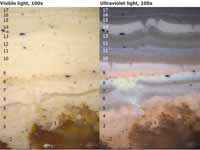 Sample NC12 from the first-floor window on the front elevation
Sample NC12 from the first-floor window on the front elevation
The three samples taken from the window just east of the front door are also in an area of first period construction. One of the three samples taken from this window has four layers of cream-colored paint with pinkish autofluorescence before a zinc white containing layer is applied. This suggests that this window does indeed date to the first period of construction as expected. In support of this Chappell noted that this window had an appearance consistent with the first period construction during sampling.
Sample NC8 from the window just east of the front door is shown below and has a full stratigraphy. The cross-section begins with four cream-colored paint layers before a bluish fluorescent paint that contains zinc white is applied.
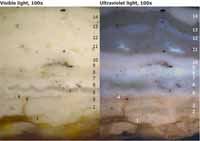 Sample NC8 from the third first-floor window from the east on the front elevation
Sample NC8 from the third first-floor window from the east on the front elevation
One sample, NC7, from the window east of the front door has evidence of an early finish not found in sample NC8 or NC17 from this same window. A paint fragment shown in the cross-sections below has a thick yellow-pigmented layer in generation two. There is too little evidence in this fragment to be sure about the stratigraphy of the finishes so the yellow layer may be a paint applied to something else that dripped onto this window. More sampling will need to be done on this window to better understand the nature of this yellow-pigmented layer.
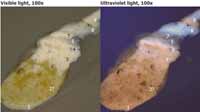 Sample NC7 from the third first-floor window from the east on the front elevation
Sample NC7 from the third first-floor window from the east on the front elevation
Only one sample was taken from the westernmost window on the front elevation which is in an area of second period construction. The cross-sections have just two generations of cream-colored paint before a zinc white containing layer is applied. There are bits of wood fibers trapped in the first cream-colored layer indicating that this is the first layer applied to this element. Thus it seems likely that this window was installed in the second period of construction as it is missing the first two cream-colored paint layers found on the eastern windows on the front elevation. The first layer in this cross-section should be the first generation of paint applied after the second period of construction and so this layer was used for color measurement. Generations six, seven, and twelve are missing from this sample.
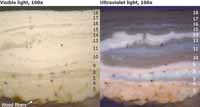 Sample NC17 from the westernmost first-floor window on the front elevation
Sample NC17 from the westernmost first-floor window on the front elevation
Two samples were taken from the southernmost window on the west elevation which is also in an area of second period construction. Chappell, however, noted that this window appears to date to the first period based on its profile and that it could have been reused from the first period construction.
The cross-section from sample NC15 that has the best evidence of early layers is shown below. It begins with two cream-colored generations of paint suggesting that this window dates to the second period of construction, not the first. The first layer corresponds with generation three on the first period windows. There are some wood fibers embedded in the paint. On this sample generation three appears darker, but this seems to be due to embedded grime and mold growth. As with sample NC17 on the previous page, generations seven, eight, and twelve are missing from this sample.
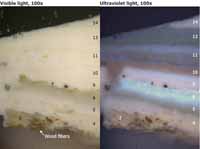 Sample NC15 from the westernmost first-floor window on the front elevation
Sample NC15 from the westernmost first-floor window on the front elevation
One sample was taken from the westernmost window on the back elevation of the house. Chappell noted that this window looks early, but could not date it to a specific period based on its appearance. Sample NC16 from this window begins with fifth generation of paint found on the first period windows. The finish history on this element suggests that it dates to a third period of construction in 1845 or after as generation five, the first layer on this sample, contains zinc white pigment. However, there is some grime under the first layer of paint that could indicate that earlier finishes have been lost. Further sampling from this window would be needed to better determine how its finish history relates to that of the other windows.
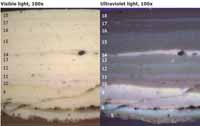 Sample NC16 from the westernmost first-floor window on the back elevation
Sample NC16 from the westernmost first-floor window on the back elevation
Cornice
Samples were taken from the cornice on the east and west end of the front elevation in areas that should date to the first and second period of construction respectively. However, samples from both sections of the cornice begin with a layer that corresponds to generation nine in first period window samples. The cross-sections from the cornice suggest that this element is a later replacement added in the late nineteenth or early twentieth century. There is no disruption or earlier material trapped in the wood cells that would indicate the cornice was an original element that has been stripped.
The cross-section from sample NC9 from the east end of the cornice is shown below and is representative of all the cornice samples. There is no evidence of disruption in the wood surface that would indicate stripping or sanding and the wood looks relatively fresh. The cross-section begins with a layer of paint that corresponds to generation nine in the first period window samples.
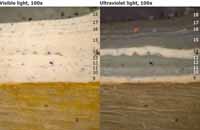 Sample NC9 from cornice fascia on the east end of the front elevation
Sample NC9 from cornice fascia on the east end of the front elevation
Doors
A sample was taken from each of the two leaves of the front door and one from the back door. Chappell noted that the rear door appears to date to around the 1940s while the front door is thought to be original. However, all of the samples begin with the same first generation of paint consisting of a cream-colored base coat and black finish coat, and in the most complete sample there are twenty-four generations of finish. This suggests that both the front and rear door are early and probably original to the house.
The two samples taken from the front door have a few different layers than the one sample taken from the rear door. A table with the comparative stratigraphies of the front and back door is given on page thirteen. The cross-section shown below from the east leaf of the front door has twenty-four generations of paint. The first generation black paint was applied over a cream-colored base coat and in some samples has a thin coat of varnish that is more readily discernible in reflected ultraviolet light. This would have yielded a very dark glossy surface. Generation two is another black paint. This paint is more visible in the cross-section on the page thirteen. Generation three is a brown paint that is very thin in this cross-section. Generation four is a gray paint found only on the rear door. Generation five is a red paint, generation six a coarsely-ground brown paint, and generation seven a light brown paint. Generation eight includes a cream-colored base coat, a red finish coat possibly with red lead pigments, and a thick natural resin varnish layer with bluish autofluorescence in ultraviolet light. This could be a faux graining scheme and it is only applied to the front door, not the rear. Generation nine is a red paint, generation ten a brown paint, generation eleven a gray paint, and generation twelve a cream-colored paint. Generations thirteen and fourteen are a blue-green paint and a red paint over a cream-colored primer, but are missing from this particular cross-section. Generation fifteen is a black paint with red pigment particles. Generation sixteen and seventeen are dark green paints. Generation eighteen is a thick gray paint, generation nineteen, twenty, and twenty-one are modern dark green paints, and generations twenty-two through twenty-four are modern gray paints.
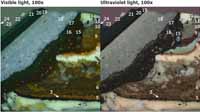 Sample NC18 from the top panel on east leaf of front door
Sample NC18 from the top panel on east leaf of front door
The cross-section below is from a second sample from the front door and it has evidence some of the layers that were missing in the previous sample. This cross-section has remnants of the varnish coat over generation twelve. The blue green paint of generation thirteen and the red paint over the cream-colored paint of generation fourteen are also present in this cross-section.
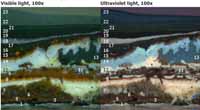 Sample NC19 from the top panel on east leaf of front door
Sample NC19 from the top panel on east leaf of front door
The sample taken from the rear door is roughly similar to that of the front door. However, the rear door has a gray paint in generation four that is missing on the front door. Generations eight, nine, eleven, and twelve on the front door are missing on the rear door. The cream-colored primer under generation fourteen is missing from the rear door. The green paints of generations sixteen and seventeen are also missing from the rear door. Thus it appears that the rear door was generally painted to match the front door since their installation The rear door has fewer layers so either some were lost to wear or the rear door was not painted as often. This cross-section has evidence of the thin varnish coat above generation one that is visible as a thin and bright fluorescent line in ultraviolet light.
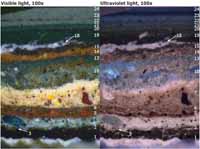 Sample NC20 from the top east panel on the rear door
Sample NC20 from the top east panel on the rear door
The table below summarizes the paint color of the various generations in the samples taken from the front and rear door.
| Generation | Samples NC18 and NC19 from the front door | Sample NC20 from the back door |
|---|---|---|
| 24 | modern gray | modern gray |
| 23 | modern gray | modern gray |
| 22 | modern gray | modern gray |
| 21 | modern green | modern green |
| 20 | modern green | modern green |
| 19 | modern green | modern green |
| 18 | gray | gray |
| 17 | green | - |
| 16 | green | - |
| 15 | black | black |
| 14 | red over cream primer | red |
| 13 | blue-green | blue-green |
| 12 | cream with resin varnish | - |
| 11 | coarse gray | - |
| 10 | brown | brown |
| 9 | red | - |
| 8 | varnish over red over cream primer | - |
| 7 | light brown | light brown |
| 6 | brown | brown |
| 5 | red | red |
| 4 | - | gray |
| 3 | brown | brown |
| 2 | black | black |
| 1 | black over cream primer | black over cream primer |
| wood substrate | wood substrate |
Binding Media Analysis
Cross-sections from sample NC12 and NC13 from what appears to be a first period window were chosen for staining since they both have good evidence of the first four generations of early cream-colored paint. Biological fluorochrome stains were applied that mark out proteins, carbohydrates, oils, and zinc (Zn2+)in the layers. There was no noticeable reaction in the early layers for proteins. There were very weak reactions for carbohydrates in the first four cream-colored paint generations and a strong reaction in generation six, as shown by a reddish-brown positive reaction color. The carbohydrates detected by the stain may be natural gums mixed into the paint binder either as a wetting agent or to help grind the pigments.
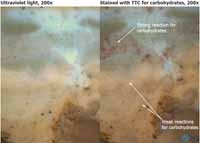 Sample NC12 from the easternmost first-floor window on the front elevation
Sample NC12 from the easternmost first-floor window on the front elevation
There were weak reactions for saturated lipids in the earliest cream-colored generations of paint shown by a pink reaction color. This suggests that the earliest generation of paints are indeed oil-bound paints. There was also a strong positive reaction for unsaturated lipids in generation five shown by a yellow reaction color.
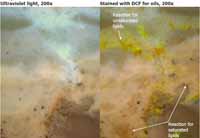 Sample NC12 from the easternmost first-floor window on the front elevation
Sample NC12 from the easternmost first-floor window on the front elevation
There were positive reactions for zinc (Zn2+) beginning in generation three, as shown by a bright blue reaction color. Since a feasible commercial method for delivering zinc white pigment in oil paint was not developed until 1845, generation five must postdate this.
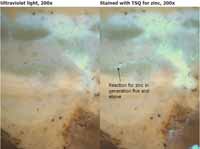 Sample NC12 from the easternmost first-floor window on the front elevation
Sample NC12 from the easternmost first-floor window on the front elevation
Pigment Identification
Pigment identification with polarized light microscopy was used to identify the pigment composition of the early paint layers. Two layers were selected for pigmented identification: the first layer in sample NC1 from what appears to be a first period window, and the first layer in sample NC17 from what appears to be a second period window. The first layer of paint in sample NC1 should represent the color of the house in the first period and the first paint in sample NC17 should be the second period color applied after the house achieve it current form.
No colored pigment particles were found in either of the early paint layers. Instead, there was only white lead pigment, and other colorless paint fillers such as chalk. This suggests that the current slightly darkened color of the early paints is caused by the degradation and darkening of the oil binder and not by the addition of colored pigment particles.
Color Measurement
In April of 2006, just before the house was to be repainted, Buck took a preliminary look at these samples and chose the second generation of paint in samples NC7 and NC9 to use for color matching. Sample NC7 was taken from the window just east of the front door which was thought to be first period. Based on evidence gathered in this report it is actually the third generation in sample NC7 which should represent the first color applied to the house after the second period of construction, not the second. Additionally, none of the samples from the cornice appear to have the early finishes. Instead the first layer in sample NC9 from the cornice corresponds to generation nine on the first period windows. Buck found that the second-generation of paint on both the window and cornice had a Munsell color value of 2.8Y for hue, 7.5 for value, and 2.3 for chroma. In the CIE L*a*b* system, she found the paint had a L* value of 76.34, an a* value of -0.04, and a b* value of +17.79. She found the best commercial paint match to the original paint to be Benjamin Moore HC26 which is different from the second generation paint by a L*a*b* ΔE value of 4.3. These color measurements were used in the replication of a modern paint that was applied to the house.
New color measurements were undertaken as part of this report and a portion of uncast material from sample NC17 from the westernmost window on the front elevation was chosen. Since cross-section microscopy evidence suggests that this window dates to the second period, the first paint layer in this sample was measured. In total six color measurements were taken from two portions of uncast material from sample NC17 and averaged. The closest actual measurement from NC17 to the average had a L* value of 76.12, an a* value of -1.67, and a b* value of +12.52 which is different from the average by a ΔE value of only 0.38. The measurement from sample NC17 is different from Buck's color measurement of sample NC7 by a ΔE value of 5.52. The closest commercial paint match to this value found is Sherwin William 2065 "Windsor Greige" which has a a L* value of 74.44, an a* value of -0.28, and a b* value of +13.79. This commercial paint color is different from the color of the first generation of paint in sample NC17 by a ΔE value of 2.52. This commercial paint match could be used for reproducing the current degraded color of the first generation of paint applied after the second period of construction.
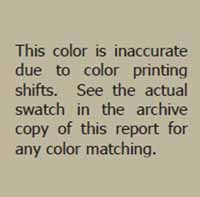 Sherwin Williams 2065, best commercial match to aged second period paint
Sherwin Williams 2065, best commercial match to aged second period paint
Since the first generation of paint in sample NC17 was found to contain lead white and no other colored pigments, its current color is probably due to embedded grime and darkening of the oil binder with age. A fresh paint composed of lead white in linseed oil would certainly originally have been much lighter, though not equal to a modern "cool" white. A batch of lead white in linseed oil paint prepared by Susan Buck was measured to have a CIE color value of L* 91.07, a* -1.26, b* 11.29. A good commercial paint match to this is Benjamin Moore OC-35 "Spanish White", which has a value of L* 90.69, a* -1.67, b* 10.31. This is different from the fresh lead white in linseed oil paint by a very low ΔE value of only 1.13. Hence, this commercial paint match could be used for reproducing an unaged lead white in linseed oil paint that the evidence suggests was first paint applied in the first generation and after the second period of construction.
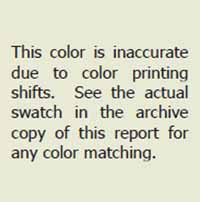 Benjamin Moore OC35, best commercial match to fresh lead white in linseed oil
Benjamin Moore OC35, best commercial match to fresh lead white in linseed oil
Conclusion
Analysis of the samples collected from the Nicolson house indicate that there is still evidence of the original paint on some elements. Cross-section microscopy analysis suggests that the two easternmost windows on the front elevation date to the first period of construction, as predicted. These windows have a finish history that begins with four generations of cream-colored paint before a zinc white containing layer is applied. The westernmost window on the front elevation and the southern window on the west elevation are assumed to date to the second period of construction and they both begin with two cream-colored paint layers before the zinc white containing layer is applied. Thus the finish history of the windows suggests that the house was painted twice in cream-colored paint before the second period construction work was undertaken.
The westernmost window on the rear elevation begins with a zinc white containing paint that corresponds to generation five on the first period window. It may be that this window represents a third period of construction that dates to around the middle of the nineteenth century.
Pigment identification was undertaken on the first generation of paint on a first period window and on the first generation of paint on a second period window. Both layers were found to be colored with lead white pigment. Other fillers were found to be present in the paint layers, but these would not provide any color. Fluorochrome staining suggests that these paint layers have oil binders. The current darkened cream color of the early layers is probably due to degradation of the oil binder with age. Analysis done for this report suggests that after both the first and second period of construction the Nicolson house was painted with a light cream-colored paint. Commercial color matches were provided in this report for the current degraded color of the first generation of paint in the second period as well as for a fresh lead white in linseed oil paint. It would be most historically accurate to repaint the house based on the fresh lead white in linseed oil paint match since this is the closest representation to how the house would have looked immediately originally.
The samples from the east and west end of the cornice on the front elevation did not yield any evidence of early paints. Instead, all the cornice samples begin with a paint that corresponds to generation nine on the first period window. There was no evidence of disruption in the wood substrate that would suggest the cornice was stripped or sanded so it is most likely to be a replacement element added in the late nineteenth or early twentieth century.
Cross-section microscopy indicates that both the front and rear doors could date to the first period of construction at the Nicolson house. Both doors share a very similar stratigraphy with only a few different colored generations. This may represent times where the two doors were painted differently, or some layers may have worn off in areas and are not present in the samples analyzed in this report. The first generation of paint on the both doors is a black paint applied over a cream-colored base coat that probably dates to the first period of construction. Generation two is another black paint that could date to the second period of construction. These first two generations are worn and cracked indicating that they were allowed to weather on the surface for some time. In some samples it appears that there may have been a resinous varnish above the black paints. This was probably added to provide increased durability and gloss. While the window frames remain mostly white or cream-colored through out their history, the doors were painted in a range of colors including red, green, brown, gray, black, tan, and cream color. There are also two generations with red paints over glazes over cream-colored base coats that probably represent graining schemes.
Footnotes
Appendix
Sampling Memorandum
To: [paintchips@juno.com]
Date: Wed, 26 Apr 2006 14:48:15 -0400
Subject: Exterior Paint at Nicolson House — Block 7, Building 12
Enclosed are exterior paint samples I took at the Nicolson House yesterday and this morning, as well as the sample (#1) you recently took. You observed that the first sample is from early woodwork too weathered to provide useful information. I believe samples #2-6 are from restoration-era (1940) woodwork and may be useful only for recognizing c.1940-81 layers. Feel free to avoid analysis of these if you wish. I am more optimistic about samples #7-16, which seem all to be from early woodwork and have a chance of being more usefully informative. In those cases, I will tell you what we know about relative dates.
Robert Nicolson appears to have built the east end of the house between 1751 and 1764 and added the west wing in 1764. Based on variation in the window frames, I think that samples 8, 13, and 14 are first-period, and 7, 9-12, and 15 could be first-period. If you find some of these informative, I can take samples from second-period windows. We can also leave these for more detailed analysis by Natasha later this year.
Taken April 15
- 1.Front elevation, east (4th) window, east architrave behind shutter. Looks old but very heavily weathered.
Taken April 25
- 2. Front elevation, 25th modillion, counting from west, east edge 1" back from front corner. Looks 20th-century.
- 3. Front elevation, 24th modillion, east face, at junction with fascia. Looks 20th-century.
- 4. Front elevation, cornice, lower fascia behind modillions, immediately east of 23rd modillion, upper edge.
- 5. Front elevation, cornice, cymatium immediately east of 24th modillion, at inner corner.
- 6. Front elevation, 14th modillion from east end, east cymatium at joint with rear cymatium.
- 7. Front elevation, 3rd first-floor window counting from west (2nd from east), west applied molding, east side at upper joint. Looks early and somewhat protected. This is on a first-period window frame but could be a somewhat later piece.
- 22
- 8.Front elevation, 3rd first-floor window, beaded inner frame, head ½" from east jamb. Looks early, relatively protected, and intact. Appears to be a first-period (c.1751-64) fabric.
- 9. Front elevation, main cornice fascia, between modillions 14 and 15, counting from east, rear edge of the drip. Protected but partially scraped in the past. Could be first-period fabric.
Taken April 26
- 1010. Front elevation, main cornice fascia, between modillions 12 and 13, counting from east, rear edge of drip. Protected. Same board as #9, possibly only original piece of main fascia surviving.
- 11.11. Front elevation, 3rd first-floor window from west, upper sash, east stile, ½" below top rail at joint with top rail. May be first-period.
- 12.12. Front elevation, 4th first-floor window from west (1st from east), upper sash, west stile, 10" below top rail, middle of stile. Like #11, may be first-period.
- 13.13. Front elevation, 4th first-floor window from west, beaded inner frame, west jamb 1" below joint with head. Appears to be first-period.
- 14.14. West elevation, south first-floor window, beaded inner frame, head 1" north of joint with south jamb. Appears to be a first-period window moved to this location in second period.
- 15.15. West elevation, south first-floor window, upper sash, top rail ½" north or south stile. May be first-period.
- 16.16. Rear elevation, 1st first-floor window from west end, face of beaded inner frame, east stile 1" below joint with head. Early but unclear which period.
- 17.17. Front elevation, 1st first-floor window, counting from west end, inner (beaded) frame, head 1" W of E jamb.
E.A.C.
[handwritten undated memo]
- A.Front door, east leaf, outer face, top panel, upper west (left) corner, top bevel at intersection with ovolo of top rail. Early fabric.
- B.Front door, west leaf, outer face, ovolo at upper west corner of upper panel. Early fabric.
- C.Rear door, top east panel bevel at upper west corner, at intersection with ovolo. May be c. 1940.
Susan - The paint shop is worried about leaving the doors and shutters at Nicolson House the existing dark green. I took these three samples, marked A, B, and C. A and B may be good — certainly they are from original (period 1?) door. C is the rear door, which is probably c. 1940. Would you be willing to take a look at A and B? Janet or I will email you an updated sample list that makes these part of the full set.
Cross-section Preparation Procedures
The samples were initially examined with a stereomicroscope under low power magnification (5 to 50 times magnification) and divided as needed. When possible, a portion of each sample was kept in reserve for future analysis and a portion cast in a labeled cube of a commercial two-part polyester resin manufactured by Excel Technologies, INC. (Enfield, CT). The resin was cured under an incandescent lamp for several hours. The resin cubes were then ground on a motorized grinding wheel with 400 grit sandpaper to reveal the cross-sections. Final finishing was achieved using a Buehler Metaserv 2000 grinder polisher equipped with abrasive cloths from Micro Mesh, INC. with grits of 1500 to 12,000.
Cross-section microscopy analysis was performed using a Nikon Eclipse 80i microscope equipped with an EXFO X-Cite 120 Fluorescence Illumination System fiberoptic halogen light source. The cross-sections were examined at magnifications of 40x, 100x, 200x, and 400x using reflected visible light and a UV-2A fluorescence filter cube with a 330-380nm excitation. The cross-sections were photographed digitally using an integral Spot Flex digital camera with Spot Advanced (v. 4.6) software. The light levels of the images were adjusted in Abode Photoshop (v. 6.0). The color on the digital images is indicative of the actual color of the paints, but cannot be used for color matching as the printing process can cause color shifts.
Under ultraviolet light many materials have characteristic autofluorescence colors that can suggest their composition. For example, most natural resin varnishes have a bright autofluorescence while an oil varnish will be dark in ultraviolet light. Visible light microscopy can also yield valuable information. The presence of soiling layers or weathering can indicate that the finish layer existed as a presentation surface for a period of time. Since many interior finishes, such as faux graining, make use of a build-up of layers, it is important to determine which layers were meant to be final presentation surfaces.
Binding Media Analysis Procedures
To better understand the composition of the paint binders, selected cross-sections were stained with biological fluorochrome stains to indicate the presence of carbohydrates, proteins, and oils in the paint binders. The stains used were ALEXA (0.1% w/v Alexafluor 488 in dimethylformamide brought to a pH of 9.0 with 0.5% Borate) which marks proteins bright green, TTC (4% w/v triphenyl tetrazolium chloride in methanol) which marks carbohydrates red-brown, DCF (0.2% w/v 2,7 dichlorofluorescein in ethanol) which marks saturated lipids pink and unsaturated lipids yellow, and TSQ (0.2% w/v N-(6-methyl-8-quinolyl)-p-toluenesulfonamide in ethanol) which marks zinc (Zn2+) blue-white.
Pigment Identification Procedures
Samples with good accumulations of early paints identified through cross-section microscopy were scraped with a scalpel under magnification to reveal the target paint layer. A small amount of this layer was then scraped onto a glass microscope slide, dispersing the pigments. The dispersed pigments were permanently embedded under a cover slip in Cargille Meltmount (Cargille Labs., Cedar Grove, NJ). The Meltmount used has a refractive index of 1.662. The prepared slides were then examined under the microscope with transmitted visible light using a polarizing filter at a magnification of 1000x with an oil immersion objective. The morphological and optical properties of the pigment particles was observed and compared to reference pigment samples.
Color Measurement Procedures
Color measurements were made using uncast samples that were selected under magnification. Effort was made to find a clean, unweathered ares for measurement whenever possible. All color measurements were made using a Minolta Chromameter CR-241 with a measurement area of 0.3mm for uncast samples and a measurement area of 1.8mm for paint swatches. This microscope has an internal, 360° pulsed xenon arc lamp and can measure color with five color systems. The color systems used in this report are the CIE (Commission International de l'Eclairage) L*a*b* and the Munsell color system. Both systems use three values called tristimulus values to measure each color which include hue (or color), the chroma (or saturation), and lightness to darkness. In the CIE L*a*b* color system L* represents lightness from 1 to 100 with 100 being the lightest, a* represents red to green with positive numbers being more red and negative numbers more green, and b* represents yellow to blue with positive numbers being more yellow and negative numbers more blue. This system was adjusted from the CIE Yxy system developed in 1931 to better represent the human eye's sensitivity to color. In the Munsell system, color measurements are given in the form of hue value/chroma with value representing lightness to darkness. Color measurement values are compared to each other using the ΔE formula which calculates the difference between to color measurements. The ΔE formula equals the square root of the sum of the differences in the L* value squared, the differences in the a* value squared, and the differences in the b* value squared. Generally, a ΔE value of less than two represents colors that are difficult for the human eye to differentiate.
Commercial color matches were found using swatches from Benjamin Moore and Sherwin Williams. The swatches were compared to the uncast sample under magnification. The best visual matches were then measured to generate a ΔE value.
